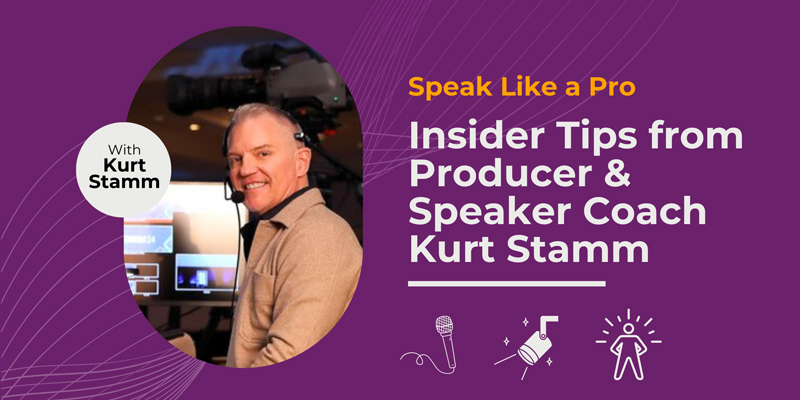
It’s possible all your presenters are seasoned, captivating public speaking pros. But more often than not, they’re executives and team leads whose primary focus isn’t public speaking, and may have a healthy dose of nerves.
That’s where Kurt Stamm comes in. With over 30 years of experience as an Executive Speaker Coach, Producer, Director, and Choreographer in both professional theater and corporate settings, Stamm specializes in transforming presenters into confident, compelling speakers. He frequently runs rehearsals for our clients, and we’re continually amazed at what an impact he makes in just a short rehearsal.
Here’s a behind-the-scenes look at how Kurt coaches speakers and runs rehearsals. We hope these public speaking insights will help you maximize your rehearsal time and show just how much a skilled coach can elevate the quality of your presentations and the confidence of your speakers.
On Building a Speaker’s Confidence
Rehearsals are about making sure everyone knows the logistics including how they’ll enter onstage, where the green room is, and who will introduce them.
But the most important use of a rehearsal is something deeper — boosting your speakers’ confidence.
First, Stamm always aims to connect with speakers on a human level, so the rapport begins before he gives them some prep. He says above all, he coaches with kindness, and ensures they know he’s rooting for them, no matter their experience level.
“I will introduce myself and say, ‘I’m your producer today. I’m here to run you through rehearsals and get you comfortable on stage’,” he says. “‘And even though you may do this quite frequently, I’m going to give you five or six things to just think about as you get up there on stage —- use them or not totally up to you.”
Stamm says being disarming and personable gives speakers a feeling of trust, and gives them an open mind to his suggestions for posture, blocking, breathing, diction, and more.
On Connecting With the Audience
Stamm also prompts speakers to reflect on the point of their speech in the first place. Spoiler: It’s not about simply delivering information. A PDF can do that.
“What is going to make this audience connect with you?” he says. “Why do they want to listen to you? You have to speak from the heart. I don’t care how dry the material is. You need to personalize it and make it yours.”
Stamm says he’s seen speakers do this by including personal stories, reflections, humor, and even pop culture references into material many would think is cut and dry. While your executives may already have their scripts set in stone by rehearsal, it’s possible they may go for that anecdote they were on the fence about, or it’s something they can consider for future events.
On Breathing
When you’re nervous, Stamm says, “you start to breathe very short shallow chest breaths that do not oxygenate your blood.” He says you need deep diaphragmatic breathing through your nose to keep your nervous system regulated.
“If you know that you’re going on stage in a minute, stand and close your eyes, take six or seven really deep breaths through your nose and fill up your diaphragm as much as you can,” he adds. “Even if you end up speeding up, you start on stage with a bit of a reserve.”
Cleveland Clinic suggests practicing diaphragmatic breathing first laying down, with “one hand on your upper chest and the other just below your rib cage. This will allow you to feel your diaphragm move as you breathe. The hand on your chest should remain as still as possible.”
On Speaking Every Word With Intention
“Speak by individual word, and understand what each one of those words actually means,” Stamm says. “Understand each word, and why you’re using it.”
Practicing speaking word by word, rather than sentence by sentence, is a completely different way to approach a speech. It makes speakers rethink their script, slows them down, and helps them deliver with more conviction.
On Running the Lights and Sound
It’s important to get your speakers onstage with real mics and real lighting during rehearsal. Letting them test the mics helps them understand how loud the volume will be when they walk onstage.
“You’re going to get a false sense of how loud your voice is, but don’t gauge your speaking level by the volume you hear,” he says. “The mic only picks up what you give me! Still give a nice, full voice.”
In other words, being too loud is rarely the issue, and the AV team will adjust accordingly.
On the Dangers Of Run-On PowerPoint Speaker Notes
Many speakers rely on their PowerPoint speaker notes to be displayed in a down stage monitor. Stamm says while this is a popular option, it’s also a recipe for monotonous, long sentences if they’re not written correctly.
Notes under the slides are written how we read, not how we speak. There’s no room for breaths in the way we write notes, and so speakers end up rushing to the end of sentences.
Instead, structure speaker notes with simple bullets or few-word phrases. If a speaker truly needs a script, Stamm says a teleprompter can be a great tool because what’s written for a teleprompter is designed for how we actually speak (though it does take practice to use it well — even newscasters have to practice it). For example, ellipses and the word “pause” are often included. Plus, it scrolls at the speaker’s pace.
Kat Cole at The Welcome Conference in 2022
On An Excellent Example of a Public Speaker: Kat Cole, CEO of AG1
If you’re looking for a stellar example of speaking, Stamm recommends checking out Kat Cole, CEO of AG1, formerly known as Athletic Greens. (Here’s a good example.) He believes she is a modern master of public speaking. Her talks are carefully planned, but she delivers them naturally and with heart.
Stamm says watch her posture — how she stays fully grounded in her feet without pacing, standing in a power pose (one foot slightly in front of the other). She uses gestures and speaks in slow, deliberate sentences. She knows the power of a pause.
He also notes how she uses zero visuals. After watching hundreds (if not thousands) of corporate addresses over the years, he thinks scrapping slides can be brilliant for speakers who want to try something new to focus on delivering a memorable, impactful message.
In conclusion, a rehearsal is about much more than checking the logistics box. It’s a chance to center your presenters, build up their confidence, and make sure they have every tool in their hands to engage your audience throughout your event.




